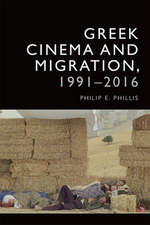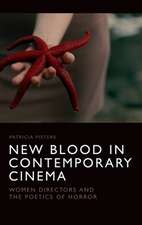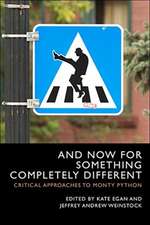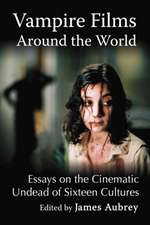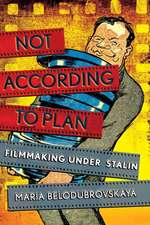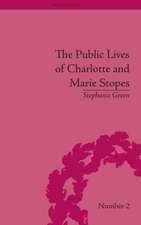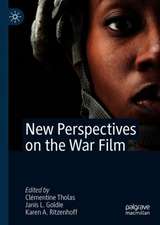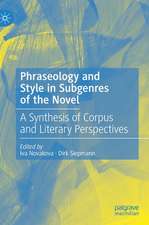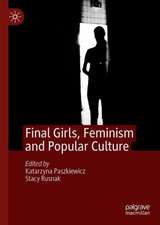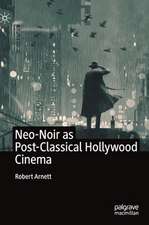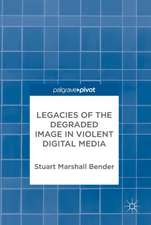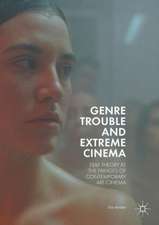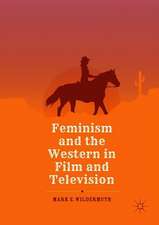Hospitality, Rape and Consent in Vampire Popular Culture: Letting the Wrong One In: Palgrave Gothic
Editat de David Baker, Stephanie Green, Agnieszka Stasiewicz-Bieńkowskaen Limba Engleză Hardback – 23 noi 2017
| Toate formatele și edițiile | Preț | Express |
|---|---|---|
| Paperback (1) | 523.22 lei 6-8 săpt. | |
| Springer International Publishing – 31 aug 2018 | 523.22 lei 6-8 săpt. | |
| Hardback (1) | 782.24 lei 6-8 săpt. | |
| Springer International Publishing – 23 noi 2017 | 782.24 lei 6-8 săpt. |
Din seria Palgrave Gothic
- 9%
 Preț: 751.76 lei
Preț: 751.76 lei - 20%
 Preț: 626.81 lei
Preț: 626.81 lei -
 Preț: 280.08 lei
Preț: 280.08 lei -
 Preț: 351.66 lei
Preț: 351.66 lei - 20%
 Preț: 690.52 lei
Preț: 690.52 lei - 15%
 Preț: 584.10 lei
Preț: 584.10 lei - 15%
 Preț: 694.22 lei
Preț: 694.22 lei - 15%
 Preț: 690.76 lei
Preț: 690.76 lei - 15%
 Preț: 586.88 lei
Preț: 586.88 lei -
 Preț: 210.55 lei
Preț: 210.55 lei -
 Preț: 351.11 lei
Preț: 351.11 lei - 18%
 Preț: 778.01 lei
Preț: 778.01 lei -
 Preț: 262.29 lei
Preț: 262.29 lei - 15%
 Preț: 635.12 lei
Preț: 635.12 lei - 15%
 Preț: 640.24 lei
Preț: 640.24 lei - 18%
 Preț: 893.21 lei
Preț: 893.21 lei - 18%
 Preț: 733.65 lei
Preț: 733.65 lei -
 Preț: 231.01 lei
Preț: 231.01 lei -
 Preț: 233.35 lei
Preț: 233.35 lei -
 Preț: 190.31 lei
Preț: 190.31 lei - 18%
 Preț: 898.26 lei
Preț: 898.26 lei -
 Preț: 387.38 lei
Preț: 387.38 lei - 15%
 Preț: 704.04 lei
Preț: 704.04 lei - 15%
 Preț: 640.88 lei
Preț: 640.88 lei - 18%
 Preț: 724.32 lei
Preț: 724.32 lei - 18%
 Preț: 788.41 lei
Preț: 788.41 lei - 18%
 Preț: 731.59 lei
Preț: 731.59 lei -
 Preț: 389.70 lei
Preț: 389.70 lei - 18%
 Preț: 731.91 lei
Preț: 731.91 lei -
 Preț: 232.16 lei
Preț: 232.16 lei - 15%
 Preț: 586.05 lei
Preț: 586.05 lei - 15%
 Preț: 698.15 lei
Preț: 698.15 lei
Preț: 782.24 lei
Preț vechi: 953.96 lei
-18% Nou
Puncte Express: 1173
Preț estimativ în valută:
149.68€ • 156.28$ • 123.88£
149.68€ • 156.28$ • 123.88£
Carte tipărită la comandă
Livrare economică 05-19 aprilie
Preluare comenzi: 021 569.72.76
Specificații
ISBN-13: 9783319627816
ISBN-10: 3319627813
Pagini: 225
Ilustrații: XXI, 225 p.
Dimensiuni: 148 x 210 mm
Greutate: 0.45 kg
Ediția:1st ed. 2017
Editura: Springer International Publishing
Colecția Palgrave Macmillan
Seria Palgrave Gothic
Locul publicării:Cham, Switzerland
ISBN-10: 3319627813
Pagini: 225
Ilustrații: XXI, 225 p.
Dimensiuni: 148 x 210 mm
Greutate: 0.45 kg
Ediția:1st ed. 2017
Editura: Springer International Publishing
Colecția Palgrave Macmillan
Seria Palgrave Gothic
Locul publicării:Cham, Switzerland
Cuprins
1. Artful Courtship and Murderous Enjoyment: Introduction - David Baker, Stephanie Green, Agnieszka Stasiewicz-Bieńkowska.- 2. Part I: The Dangers of Crossing the Threshold: The Interplay of Power between Host and Guest. 2. Crossing Borders: Hospitality in Bram Stoker’s Dracula and Florence Marryat’s The Blood of the Vampire - Maria Parrino.- 3. “Come on in!” Home, Hospitality and the Construction of Power in The Originals - Verena Bernardi.- 4. Fans and Vampires at Home - Lucy I. Baker.- 5. Breaking and Entering: Psychic Violation, Metempsychosis and the Uninvited Female Vampire - Simon Bacon.- 6. Part II - Vampiric Bodies: History, Humanity and Subversion. 6. Time and the Vampire: The Idea of the Past in Carmilla and Dracula - Stephanie Green.- 7. Breach of Consent: Jean Rollin and Le Viol du Vampire - David Baker.- 8. Part III - Those Bloody Kids: Consent, Liminality and the Uncanny in the Figure of Vampire Child. 8. Coming of Age, With Vampires - Amanda Howell.- 9. Consensual and Nonconsensual Sucking: Vampires and Transitional Phenomena - Terrie Waddell.- 10. Part IV - Bloody Romance: Vampires in Intimate Relationships. 10. It’s a Love Story—Involving Vampires: The Cinematic Trope of the Wedded Bloodsucker - Samantha Lindop.- 11. The Lower Dog in the Room: Patriarchal Terrorism and the Question of Consent in Charlaine Harris’s The Southern Vampire Mysteries - Agnieszka Stasiewicz-Bieńkowska.- 12. Seductive Kindness: Power, Space and “Lesbian” Vampires - Alexandra Heller-Nicholas.
Recenzii
“Presents a multitude of perspectives and analyses … . Each writer has a unique outlook with extremely well-supported arguments, with some thought-provoking discussion that stays with you when consuming vampire fiction. A range of texts are analysed, from literature to film to television shows, covering a wide variety of classic and contemporary fiction. The essays all build on previously made points regarding literary vampirism, without rehashing old debates. All-in-all, this volume is a refreshing and provocative read.” (Robin Moon, Journal of Vampire Studies, Vol. 2 (1), 2021)
Notă biografică
Dr David Baker lectures in film studies at the School of Humanities, Languages and Social Science at Griffith University, Australia. He is author of “Bowie’s Covers, The Artist as Modernist” in Enchanting David Bowie (ed. T. Cinque, Ch. Moore and S. Redmond; 2015), and publishes widely on popular cinema genres.
Dr Stephanie Green is Deputy Head of School in Humanities, Languages and Social Science at Griffith University, Australia, and author of ‘Desiring Dexter: The Pangs and Pleasures of Serial Killer Body Technique’, Continuum 26 2012, 579-588 and The Public Lives of Charlotte and Marie Stopes (2013).
Dr Agnieszka Stasiewicz-Bieńkowska is Associate Professor at the Institute of American Studies and Polish Diaspora, Jagiellonian University, Poland; author of Constructing Ethnic Identity of Swedish-American Children: Augustana Book Concern (1889-1962) (2011, in Polish), and co-editor of MonstrousManifestations: Realities and Imaginings of the Monster (2013).
Dr Stephanie Green is Deputy Head of School in Humanities, Languages and Social Science at Griffith University, Australia, and author of ‘Desiring Dexter: The Pangs and Pleasures of Serial Killer Body Technique’, Continuum 26 2012, 579-588 and The Public Lives of Charlotte and Marie Stopes (2013).
Dr Agnieszka Stasiewicz-Bieńkowska is Associate Professor at the Institute of American Studies and Polish Diaspora, Jagiellonian University, Poland; author of Constructing Ethnic Identity of Swedish-American Children: Augustana Book Concern (1889-1962) (2011, in Polish), and co-editor of MonstrousManifestations: Realities and Imaginings of the Monster (2013).
Textul de pe ultima copertă
This unique study explores the vampire as host and guest, captor and hostage: a perfect lover and force of seductive predation. From Dracula and Carmilla, to True Blood and The Originals, the figure of the vampire embodies taboos and desires about hospitality, rape and consent. The first section welcomes the reader into ominous spaces of home, examining the vampire through concepts of hospitality and power, the metaphor of threshold, and the blurred boundaries between visitation, invasion and confinement. Section two reflects upon the historical development of vampire narratives and the monster as oppressed, alienated Other. Section three discusses cultural anxieties of youth, (im)maturity, childhood agency, abuse and the age of consent. The final section addresses vampire as intimate partner, mapping boundaries between invitation, passion and coercion. With its fresh insight into vampire genre, this book will appeal to academics, students and general public alike.
Caracteristici
Offers a fresh and provocative insight not only into vampire genres, but also into anxieties of cultures and societies that produce them Illuminates the role of the vampire as an embodiment of the violent and violated, oppressive and oppressed Other who provokes fear and fascination Focuses on intersecting themes of hospitality, rape and consent in the vampire tradition Includes supplementary material: sn.pub/extras





